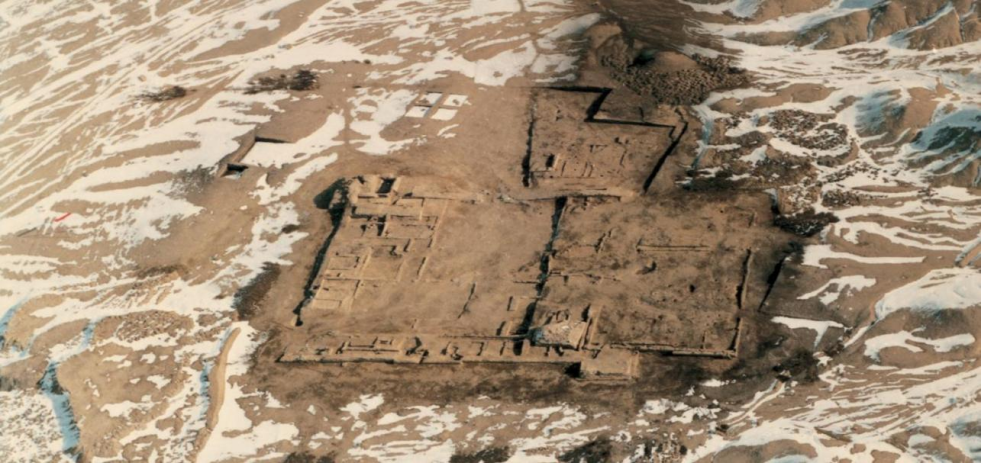
World Cultural Heritage
Dunhuang City and Guazhou County in northwest China's Gansu Province are parts of the ancient Dunhuang region and home to two existing World Cultural Heritage sites: the Mogao Caves, the Yumen Pass ruins and the Xuanquan Posthouse Site.
The Mogao Caves, located 25 kilometers southeast of Dunhuang City at the eastern foot of Mingsha (Sounding Sand) Hill, are numbered among the "Three Great Grottoes of China" alongside the Yungang Grottoes in Datong, Shanxi Province, and the Longmen Grottoes in Luoyang, Henan Province. The 735 caves, 45,000 square meters of murals, and more than 2,400 painted statues have collectively earned titles such as "the largest gallery in the world" and "the Louvre on the Orient". The UNESCO World Heritage Committee evaluated the Mogao Caves as such: "Situated at a strategic point along the Silk Route, at the crossroads of trade as well as religious, cultural and intellectual influences, the 492 cells and cave sanctuaries in Mogao are famous for their statues and wall paintings, spanning 1,000 years of Buddhist art."
Yumen Pass, established in 111 BC during the Western Han Dynasty, is located approximately 90 kilometers northwest of today's Dunhuang City along the Shule River. Its ruins encompass the remains of Xiaofangpan Fort, Dafangpan Fort, sections of the Han-dynasty Great Wall, and beacon towers. The site includes 20 beacon towers and 18 segments of the Han-era frontier wall stretching from Cangting Beacon in the east to Xianming Beacon in the west. These structures are distributed linearly across a corridor measuring 45 kilometers long and 0.5 kilometers wide centered around the Xiaofangpan Fort ruins. As a strategic pass in the routes network of the Chang'an-Tianshan corridor along the Silk Road, the Yumen Pass ruins provide critical archaeological evidence to date and determine the function of Xiaofangpan and Dafangpan Forts and map the precise route and direction of the ancient post road, and served as a vital gateway between the Central Plains and the Western Regions.
Located at the boundary between Dunhuang City and Guazhou County, the Xuanquan Posthouse Site is the highest-ranking post station of the Han-dynasty postal system. Its main responsibilities were twofold: first, to accommodate travelers by providing food, lodging, and transportation; second, to relay government orders and mail. Discovery of the Xuanquan Posthouse Site pinpointed the specific route of the Silk Road across the area. Remains of a real post station along the Silk Road pointed to a network of routes from Chang'an to the Tianshan Mountain Corridor and provided confirmation of the historicity of this transportation route. The Han-dynasty bamboo slips unearthed there meticulously document the operations of the Silk Road during the Han and Jin (265-420) dynasties, detailing how it was managed and showcasing the frequent interactions between the Central Plains dynasties and the vast Western Regions.

敦煌的世界文化遺產(chǎn)
甘肅省敦煌市和瓜州縣屬于古代敦煌地域范圍,現(xiàn)存3處世界文化遺產(chǎn),即莫高窟、玉門關(guān)遺址和懸泉置遺址。
莫高窟位于甘肅省敦煌市區(qū)東南25千米鳴沙山東麓的斷崖上,與山西大同云岡石窟、河南洛陽龍門石窟并稱“中國三大石窟”。莫高窟現(xiàn)存735個(gè)洞窟、45000平方米壁畫、2400多尊彩塑,被譽(yù)為“全世界最大的畫廊”“東方的盧浮宮”。世界遺產(chǎn)委員會對莫高窟的評價(jià)是:“莫高窟地處絲綢之路的一個(gè)戰(zhàn)略要點(diǎn)。它不僅是東西方貿(mào)易的中轉(zhuǎn)站,同時(shí)也是宗教、文化和知識的交匯處。莫高窟的492個(gè)小石窟和洞穴廟宇,以其塑像和壁畫聞名于世,展示了延續(xù)千年的佛教藝術(shù)。”
玉門關(guān)設(shè)于西漢元鼎六年(前111),位于距今敦煌市西北90千米的疏勒河邊。漢玉門關(guān)遺址區(qū)包括小方盤城、大方盤城、漢長城邊墻及烽燧遺址,包括20座烽燧、18段長城邊墻遺址,東起倉亭燧,西至顯明燧,在長約45千米、寬約0.5千米的區(qū)域內(nèi)以小方盤城遺址為中心呈線性分布。作為“絲綢之路:長安—天山廊道的路網(wǎng)”上的重要關(guān)隘,玉門關(guān)遺址確定了小方盤城和大方盤城遺存年代、性質(zhì),以及古驛道具體位置和走向,是古代中原通往西域的重要門戶。
懸泉置遺址位于敦煌市與瓜州縣交界處,是中國漢代郵驛系統(tǒng)中級別最高的驛站。其主要職責(zé)有二:一是接待過往人員,提供飲食、住宿、車馬;二是傳遞政令和郵書。懸泉置遺址的發(fā)現(xiàn),重點(diǎn)標(biāo)注了絲綢之路在這一路段的具體走向,作為 “絲綢之路:長安—天山廊道的路網(wǎng)”真實(shí)存在的驛站,第一次確證了絲綢之路這條交通線在歷史上的存在。懸泉置出土的漢簡,從機(jī)構(gòu)、人員、運(yùn)作到往來,詳細(xì)地記錄了漢晉時(shí)期如何經(jīng)營絲綢之路,展現(xiàn)了中原王朝與廣大西域地區(qū)頻繁交往的史實(shí)。

